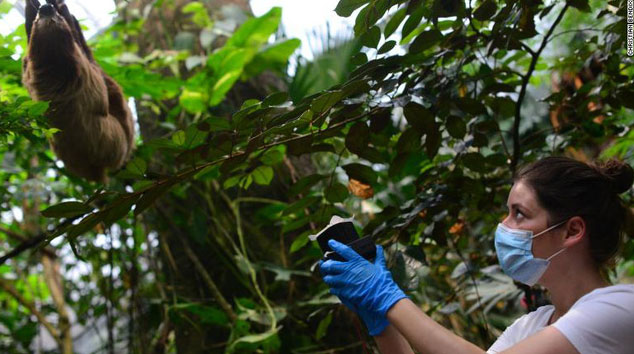DNA in the air - interesting living proof
International scientists in Denmark, the UK and Canada have now been able to collect and analyze DNA - the molecule containing genetic material and genes - extracted from the air.
This groundbreaking new technique is used to protect endangered animals and natural ecosystems, according to CNN.

Associate Professor Kristine Bohmann at the University of Copenhagen (Denmark) is collecting air samples
All living things, including humans, "discharge" DNA genetic material into the environment through excretion of waste, bleeding, and shedding of skin or hair.
Two groups of scientists working independently - one in Denmark and the other in the UK and Canada - tested whether airborne DNA could be used to detect different animals. They collected samples at Copenhagen Zoo in Denmark and at Hamerton Zoo park in the UK.
While using different methods to filter DNA from the air, both groups were successful in identifying animals that lived nearby, including inside the zoo's enclosure and outside. Their study was published in the journal Current Biology on January 6.
Lead author of the UK-based study, Elizabeth Clare, an assistant professor at York University in Canada, said the team at Hamerton Zoo Park had identified the DNA of 25 different animals, including including tigers, lemurs and dingoes.
"We were able to even collect DNA from animals hundreds of meters away from the test site and even from enclosed buildings outside, and still not experience a significant drop in concentrations," said Ms. ADN".
The Copenhagen team discovered 49 species of vertebrates, including 30 mammals.
Kristine Bohmann, an associate professor at the Globe Institute at the University of Copenhagen and lead author of the study in Denmark, explains: "We were surprised when we got the results. Out of just 40 samples, we were able to get our results. discovered 49 species including mammals, birds, amphibians, reptiles and fish.
At Rainforest House (Copenhagen Zoo) we even spotted guppies in the pond, a two-toed sloth. When we sampled the air in just one outdoor location, we detected many other animals such as ostriches and rhinos."
The University of Copenhagen team used a fan to draw air from the zoo and its surroundings. From there, they extracted the DNA and copied it before it was sequenced, to identify the animal.
Both research groups have also detected the presence of non-zoo animals, including Eurasian porcupines - endangered in the UK - discovered from outside Hamerton Zoo. While water langurs and red squirrels were spotted around Copenhagen Zoo.
The scientists believe the technique could help them map species and eliminate the need for traps.
The non-invasive nature of this method is of particular value in observing vulnerable or endangered species and those in hard-to-reach environments, such as caves.
These DNA-related techniques also have a significant impact in scientific research. Archaeologists are using DNA found in cave dust to understand ancient human populations.
- Swallowing moisture-proof seeds is dangerous?
- Research and develop explosion-proof batteries
- Shock proof: Are living things present on Venus?
- 12 horrible things about China you may not know
- Fabrication of explosion proof glass
- Germany successfully researched explosion-proof batteries
- Animal World - Interesting things you don't know
- Manufacture of new 6mm thick explosion-proof glass
- 22 billion years more Earth will explode?
- The 10 most interesting mysteries of lost civilizations (Part 1)
- Interesting findings about chimp's sleeping place
- 10 interesting things about life you may not know
 'Fine laughs' - Scary and painful torture in ancient times
'Fine laughs' - Scary and painful torture in ancient times The sequence of numbers 142857 of the Egyptian pyramids is known as the strangest number in the world - Why?
The sequence of numbers 142857 of the Egyptian pyramids is known as the strangest number in the world - Why? History of the iron
History of the iron What is alum?
What is alum? Scientists find traces of modification in DNA: Are humans products of 'design'?
Scientists find traces of modification in DNA: Are humans products of 'design'?  A surprising kitchen tool helps preserve endangered species
A surprising kitchen tool helps preserve endangered species  Discovery of strange activity of ancient virus DNA in the human body
Discovery of strange activity of ancient virus DNA in the human body  Japan announces new breakthrough to help destroy many types of cancer
Japan announces new breakthrough to help destroy many types of cancer  Protein discovered as a precursor to cancer vaccine
Protein discovered as a precursor to cancer vaccine  The relationship between ancient viral DNA and mental illness
The relationship between ancient viral DNA and mental illness 